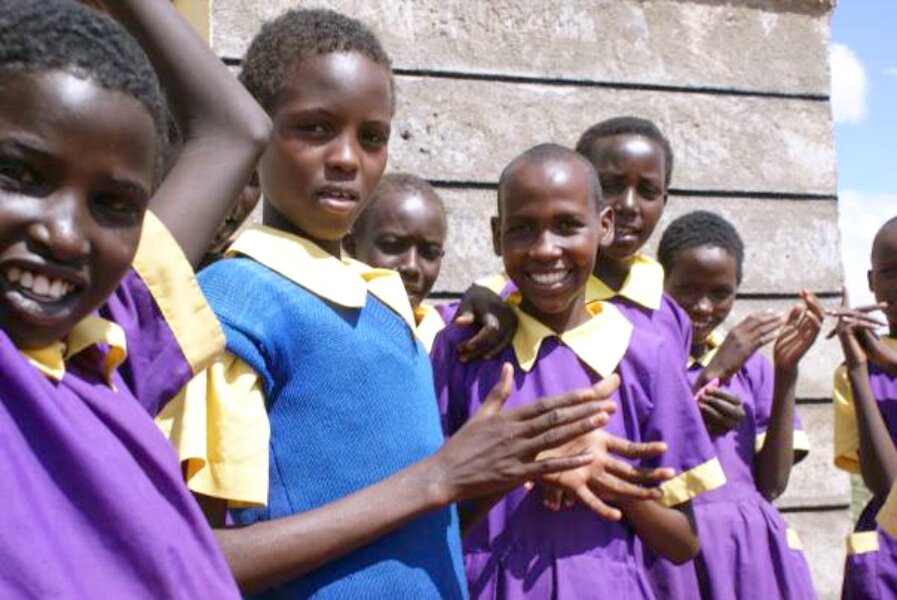Mobile schools educate girls in rural Kenya
Loading...
| LAISAMIS, Kenya
At 16 years of age, Nagirasia Lengima is already a mother of two. But parenthood doesn't stop her from indulging in her latest passion: school.
Like a growing number of girls from nomadic communities in northern Kenya, Lengima is defying cultural prejudices – and climate pressures – by getting an education at a mobile school.
Run by nonprofit groups, the schools bring learning to girls whose families are forced to move around the region to survive.
In Laisamis village, Marsabit County, at a school run by the Nairobi-based development charity Adeso, it is Lengima's turn to demonstrate what she has picked up from the morning session.
After playing around with some numbers on the chalkboard, she elicits cheers from the 59 other pupils in the class as she produces the answer with a double stroke.
"Mathematics and Kiswahili are my favorite subjects," said Lengima. "I want to go into business in the future."
But circumstances are conspiring against her. Teachers have largely abandoned the area to escape sporadic attacks by Islamist militant group Al Shabaab.
And increasingly erratic weather often pushes pastoralist families away from their settlements in search of water and grazing, limiting children's access to formal education.
Temperatures in northern Kenya can reach over 30 degrees C. (86 degrees F.), and the region regularly suffers from both drought and heavy rainfall.
Adeso works with the weather to give girls access to informal schooling, which otherwise may have been impossible.
"The school calendar is based around rainfall patterns," said Saadia Maalim Mohamed, project officer with Adeso, which teaches 300 girls between the ages of 13 and 18 in Laisamis village and runs several other mobile schools around Kenya. "Learning takes place during the rainy season when labor demand on the children is low and movement of communities is minimal."
According to officials, Marsabit County reports the worst education indicators in Kenya, with literacy levels at just 20 percent and poverty at 92 percent.
Less than 15 percent of girls over the age of six have ever attended school, and of those who do, most end up dropping out. With few options for a better life, girls usually marry young to start families.
"In more settled communities it is usually boys who are sent to school," said Jonathan Kulmisha, a social activist in Marsabit. "Girls are given the responsibility of household chores and livestock herding."
But some, like Lengima, decide to restart their education, and mobile schools give them the chance to catch up.
Every day Lengima wakes up at 5 a.m., attends to her morning duties, and then heads off to the tent - equipped with chalkboards, desks and chairs - that serves as her classroom.
She knows that in a few weeks' time, the rains will stop and the terrain will once more be parched with the onset of the dry season.
"I try to learn as much as possible because after the rains we will move to faraway places in search of pasture," she said. The school will go with them, as far as it can.
"Our teachers may not be able to survive in some of the distant territories," said Lengima.
Launched in February 2014, the Adeso school project is scheduled to end in 2016, when the money runs out.
The group is raising funds in the hope of extending the project, but faces challenges such as political insecurity, poor road and phone networks, and "backwards" cultural beliefs that discourage girls' education, said Adeso official Mohamed.
For now, Mohamed is optimistic that the influence of the mobile schools will extend beyond the classroom, as the students pass on what they have learned to their communities.
When Lengima arrives back at her village after school, she likes to reflect on the day's lessons and share the highlights with other women as they attend to their evening chores.
Lengima chats about the environment and climate change. These are new issues to most of the women, but Lengima is good at explaining how the unfamiliar concepts affect their lives.
"At the mobile school, pupils learn how to adapt to unpredictable weather due to global warming," said activist Kulmisha. "The people of the community used to think the droughts and heavy rains were the work of witchcraft. After interacting with the pupils, they know better."
• Reporting by Kagondu Njagi; editing by Jumana Farouky and Megan Rowling.
• This article originally appeared at Thomson Reuters Foundation, a source of news, information, and connections for action. It provides programs that trigger change, empower people, and offer concrete solutions.





